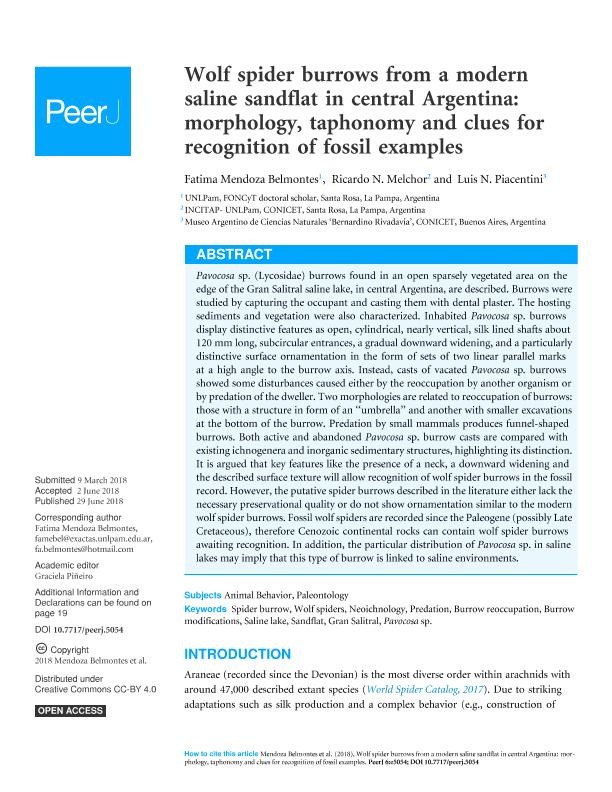Mostrar el registro sencillo del ítem
dc.contributor.author
Mendoza Belmontes, Fatima del Rosario

dc.contributor.author
Melchor, Ricardo Nestor

dc.contributor.author
Piacentini, Luis Norberto

dc.date.available
2019-08-12T20:11:18Z
dc.date.issued
2018-06
dc.identifier.citation
Mendoza Belmontes, Fatima del Rosario; Melchor, Ricardo Nestor; Piacentini, Luis Norberto; Wolf spider burrows from a modern saline sandflat in central Argentina: Morphology, taphonomy and clues for recognition of fossil examples; PeerJ Inc.; PeerJ; 2018; 6; 6-2018; 1-26
dc.identifier.issn
2167-8359
dc.identifier.uri
http://hdl.handle.net/11336/81506
dc.description.abstract
Pavocosa sp. (Lycosidae) burrows found in an open sparsely vegetated area on the edge of the Gran Salitral saline lake, in central Argentina, are described. Burrows were studied by capturing the occupant and casting them with dental plaster. The hosting sediments and vegetation were also characterized. Inhabited Pavocosa sp. burrows display distinctive features as open, cylindrical, nearly vertical, silk lined shafts about 120 mm long, subcircular entrances, a gradual downward widening, and a particularly distinctive surface ornamentation in the form of sets of two linear parallel marks at a high angle to the burrow axis. Instead, casts of vacated Pavocosa sp. burrows showed some disturbances caused either by the reoccupation by another organism or by predation of the dweller. Two morphologies are related to reoccupation of burrows: those with a structure in form of an ``umbrella'' and another with smaller excavations at the bottom of the burrow. Predation by small mammals produces funnel-shaped burrows. Both active and abandoned Pavocosa sp. burrow casts are compared with existing ichnogenera and inorganic sedimentary structures, highlighting its distinction. It is argued that key features like the presence of a neck, a downward widening and the described surface texture will allow recognition of wolf spider burrows in the fossil record. However, the putative spider burrows described in the literature either lack the necessary preservational quality or do not show ornamentation similar to the modern wolf spider burrows. Fossil wolf spiders are recorded since the Paleogene (possibly Late Cretaceous), therefore Cenozoic continental rocks can contain wolf spider burrows awaiting recognition. In addition, the particular distribution of Pavocosa sp. in saline lakes may imply that this type of burrow is linked to saline environments.
dc.format
application/pdf
dc.language.iso
eng
dc.publisher
PeerJ Inc.
dc.rights
info:eu-repo/semantics/openAccess
dc.rights.uri
https://creativecommons.org/licenses/by-nc-sa/2.5/ar/
dc.subject
Burrow Modifications
dc.subject
Burrow Reoccupation
dc.subject
Gran Salitral
dc.subject
Neoichnology
dc.subject
Pavocosa Sp
dc.subject
Predation
dc.subject
Saline Lake
dc.subject
Sandflat
dc.subject
Spider Burrow
dc.subject
Wolf Spiders
dc.subject.classification
Meteorología y Ciencias Atmosféricas

dc.subject.classification
Ciencias de la Tierra y relacionadas con el Medio Ambiente

dc.subject.classification
CIENCIAS NATURALES Y EXACTAS

dc.title
Wolf spider burrows from a modern saline sandflat in central Argentina: Morphology, taphonomy and clues for recognition of fossil examples
dc.type
info:eu-repo/semantics/article
dc.type
info:ar-repo/semantics/artículo
dc.type
info:eu-repo/semantics/publishedVersion
dc.date.updated
2019-08-09T15:04:41Z
dc.journal.volume
2018
dc.journal.number
6
dc.journal.pagination
1-26
dc.journal.pais
Estados Unidos

dc.journal.ciudad
San Diego
dc.description.fil
Fil: Mendoza Belmontes, Fatima del Rosario. Ministerio de Ciencia, Tecnología e Innovación Productiva. Agencia Nacional de Promoción Científica y Tecnológica. Fondo para la Investigación Científica y Tecnológica; Argentina. Universidad Nacional de La Pampa; Argentina
dc.description.fil
Fil: Melchor, Ricardo Nestor. Consejo Nacional de Investigaciones Científicas y Técnicas. Instituto de Ciencias de la Tierra y Ambientales de La Pampa. Universidad Nacional de La Pampa. Facultad de Ciencias Exactas y Naturales. Instituto de Ciencias de la Tierra y Ambientales de La Pampa; Argentina
dc.description.fil
Fil: Piacentini, Luis Norberto. Consejo Nacional de Investigaciones Científicas y Técnicas. Oficina de Coordinación Administrativa Parque Centenario. Museo Argentino de Ciencias Naturales “Bernardino Rivadavia”; Argentina
dc.journal.title
PeerJ
dc.relation.alternativeid
info:eu-repo/semantics/altIdentifier/url/https://peerj.com/articles/5054
dc.relation.alternativeid
info:eu-repo/semantics/altIdentifier/doi/https://doi.org/10.7717/peerj.5054
Archivos asociados
